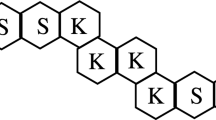Abstract
Permutation group-theoretical methods are used to study the chiralization of achiral polyhedral skeletons with v vertices by successive ligand replacement. Starting from the fully symmetrical ligand partition (ν), such chiralization processes may be characterized either by the minimum number of ligand replacement steps m, or the minimum number of different kinds of ligandsi, required to destroy all improper rotations. These parameters are trivially related to the lowest degree chiral ligand partition(s) as determined by the subduction of the skeleton point group G into the corresponding symmetric groupS ν by the procedure of Ruch and Schönhofer. Two different chiralization pathways with different values ofm andi are found for the octahedron, cube, hexagonal bipyramid, and icosahedron. Many less symmetrical chemically significant polyhedra have the degree 2 ligand partition (v - 2, 2) as the lowest degree chiral ligand partition and thus have only one chiralization pathway. Such polyhedra include the bicapped tetrahedron, trigonal prism, capped octahedron, bisdisphenoid, square antiprism, 4, 4, 4-tricapped trigonal prism, 4-capped square antiprism, 4,4-bicapped square antiprism, and the cuboctahedron.
Similar content being viewed by others
References
For part XXIII of this series, see R.B. King, J. Comput. Chem. 8(1987)341.
V.I. Sokolov, Zhur. Strukt. Khim. 17 (1976)743; Russ. J. Struct. Chem. 17(1976)642.
E. Ruch and A. Schönhofer, Theor. Chim. Acta (Berl.) 10 (1968)91.
E. Ruch and A. Schönhofer, Theor. Chim. Acta (Berl.) 19 (1970)225.
E. Ruch, Accts. Chem. Res. 5 (1972)49.
C.A. Mead, Top. Curr. Chem. 49 (1974)1.
R.B. King, Theor. Chim. Acta (Berl.) 63 (1983)103.
R.B. King, J. Math. Chem. 1 (1987)15.
R.B. King, J. Math. Chem. 1 (1987)45.
C.D.H. Chisholm,Group Theoretical Techniques in Quantum Chemistry (Academic Press, New York, 1976) Ch. 6.
S.L. Altmann,Induced Representations in Crystals and Molecules (Academic Press, London, 1977).
D.E. Littlewood and A.R. Richardson, Phil. Trans. Roy. Soc. (London) Series A233(1934) 99.
M. Zia-ud-Din, Proc. London Math. Soc. 39 (1935)200.
M. Zia-ud-Din, Proc. London Math. Soc. 42 (1936)340.
F.A. Cotton,Chemical Applications of Group Theory (Wiley, New York, 1971).
D. Gorenstein,Finite Groups (Harper and Row, New York, 1968) Ch. 4.
Author information
Authors and Affiliations
Rights and permissions
About this article
Cite this article
King, R.B. Chemical applications of topology and group Theory. XXIV: Chiralization of chemically significant polyhedra [1]. J Math Chem 1, 415–421 (1987). https://doi.org/10.1007/BF01205070
Received:
Issue Date:
DOI: https://doi.org/10.1007/BF01205070




